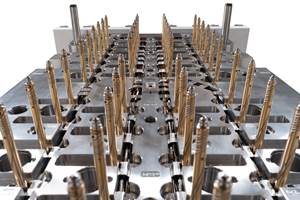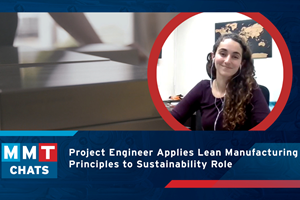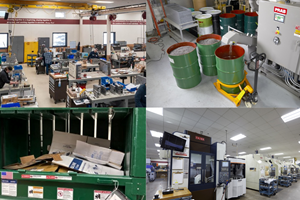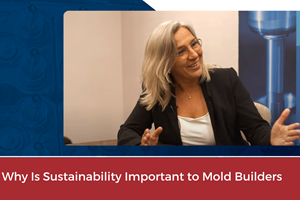How to Improve Your Business to be Best-in-Class
In today’s business climate, if mold manufacturers are not growing then they are not sustainable. To ensure your growth take a look at what you need to be concerned about as you move forward.
As Harbour Results tours and assesses mold building operations, we have found that there are a handful of companies whose businesses are really excelling and pulling away from the rest of the pack. They are innovative, creative, profitable and constantly challenging the business to be better. On the other hand, there is a group of suppliers that is well below average in overall performance, struggling to make money, meet deadlines and overall customer expectations. The largest group of shops is right in the middle.
These suppliers are mediocre yet have a strong enough brand and enough new business to stay in the game. However, this group is not doing anything creative to improve their business to be best-in-class. These suppliers will have to make some decisions in the coming year on what they need to do in order to move up the scale to best-in-class status, or watch their companies fall back further in the pack.
Going forward, there are many pressures on the tooling industry that companies still have to face. Currently, the climate looks good and many have already forgotten about the recession of 2008 – 2010, but more rough times are ahead. Tooling is a brutal market and there are several things that companies have to consider moving forward.
Capacity Constraints
Many mold builders have leverage today and are even turning away work because they are too full. This is a position that companies have not been in for a long time. That said, companies have to be wise about this capacity and plan for the future when customers level out their product cadence and new programs get back to a normal release schedule. Companies need to develop the ability to sell value versus capacity and know how to maintain that in 2015 and beyond when the market shifts again. This return from the recession is not a 10-year wave; it is only a 2 to 3 year wave.
Companies sell value and not capacity through a series of actions. They have to first work on the upfront sales and relationship piece. OEMs and big companies want tool suppliers to be as transparent as possible with them about opportunities for improvement and ways to work better with their customer, which is usually the middle man (i.e. GM / JCI / Tool shop). The relationship between tool shop and OEM (GM) is as important as tool shops to their direct customers. They need to position themselves as the transparent tool shop committed to the OEM.
This will allow them to get a handle on demand planning. Really get to know their customers, study the data and know in detail what customers will expect of them in the future. As companies then land business, they need to execute at the cost target, and most importantly, at the timing required. After that perform lessons learned and develop the systems to continuously improve. Companies will then make the profit necessary to be pickier about their customers and sell the value required. If they can hold their position of value—and hold firm—they can be successful.
Quoting Factories
Many companies today have become quoting factories and as a result, a great deal of transactional waste has been added to the upfront process internally. Much manpower and substantial time is spent in this area today, and in many cases, on quotes that will never materialize into anything except for price testing. Companies should be careful to manage cost in this area. This is an area that most companies do not consider working on to improve throughput and efficiency. Companies tend to focus on manufacturing and where to make improvement that they can see and feel and touch. With volume increasing, product cadence complexity from all customers and the demand to replace new products tool shops are quoting like crazy. But they are not analyzing the data enough to determine where to spend their time and energy. Instead they are turning to hiring new estimators or dedicated quoters and that is adding cost. There is little work done on efficiency.
The best companies are analyzing their quote data differently than in the past. They are looking at the last 3 to 5 years of data and reporting on each customer and the total quote revenue in a given year. They are looking at the hit rate for those customers and determining which 10 to 20 customers generate the most business. Then they are developing filters in the quote process that allow them to focus on a set of criteria.
That criteria has to do with the top 10 customers that are giving them work, but also what strategic elements make sense to quote work—such as a new customer they are trying to land, etc. This area of the business is no different than operations. Companies are developing process maps of the quoting process in order to focus on waste elimination and improve throughput in quoting; taking less time and pushing more quotes through with standardized work and processes.
Increased Volumes
Today, the majority of mold builders is very busy. In fact, these shops are being challenged by these increased volumes. Many companies were not prepared for these volume increases and they are struggling to meet timing due to a lack of resources and systems to support the growth. Companies are throwing waste at the process and this could lead to negative returns in the near future and loss of a competitive edge as market conditions swing back to realistic levels.
One of the problems is that all the companies are redoing their models today to replenish from the recession; however, those companies did not add resources to push the elephant through the snake in their own companies, so in most cases they are way behind schedule, which puts huge pressure on tool shops to deliver in timing.
All the shops that the big guys previously used are busy now with their own business and capacity is really tight. So the timing issues are not all their problem. Many are driven by the customer and the lack of outsourced support. However, the biggest issue is the lack of skilled trades. In the recession those companies killed the apprentice programs and now they don’t have the next generation there to take over in the next 5 years. They are scrambling to find apprentices now, but more importantly they are looking to find experienced people.
Some shops are buying away people with big increases in salary, which is a difficult proposition for the future. Others that have the resources are actually buying up smaller tool shops not just for the equipment assets, but to obtain 15 to 20 mold builders in the acquisition.
Companies are beginning to purchase equipment again, but that is a challenge because new machines are difficult to get in the timing needed, and the used equipment market just doesn’t have machines any more. There are many that have the financial resources now because they cleaned up their balance sheets and are making money again, but just can’t find the best resources to add to their companies.
Skilled Labor
Probably the largest problem for all toolmakers today is the lack of skilled labor and people to fill the many new jobs in companies. This is an area where toolmakers need to put their money on the table and work with local high schools and colleges to find the right motivated people and then put them in an extensive apprenticeship program.
Companies are struggling with this more than any other issue at this point. There are lots of reasons for this, but primarily because parents have pushed kids into university rather than to manufacturing because they wanted them to have a differently future. However, the number of white collar jobs is the fewest and now kids are graduating and not finding jobs. Manufacturing has the largest amount of available jobs and the least number of people to fill them.
Tool shops are not able to get the skilled labor they want and need from schools and local sources. The bottom line is that they need to put money out there and invest in their own programs. This means developing a solid apprentice program and hiring young capable people to train for the future. Then invest in these people to develop the future. I don’t think companies can rely on government, colleges or any other source to develop talent.
That said people need to be working with the high schools and parents on a marketing campaign to illustrate that manufacturing is a good place to work and that the money long term is a great middle class job. Companies need to change their messaging and focus less on trade school or vocational school, and more on a good middle class, highly skilled job that requires math and science and allows kids to work in a highly technical environment. Schools won’t train these people; tool shops will have to make the commitment and investment to find and train the future generation.
Pricing
This is an area that will always be under heavy scrutiny and it will only continue to get tighter as companies release new programs with lower budgets, but more complexity of product. This complexity will drive more discrete tools and added cost, which will force pricing down for each separate tool.
Companies have to focus on the cost side of the equation in their business. They need to learn to do more with the same and drive throughput, which will make them more profitable. In doing this companies will be able to make pricing more competitive while still making money.
The best companies are designing standard tools in a common format and selling these to their customers based on the commodities. This allows them to reduce engineering hours and sell a template. This makes them more capable of flexing their business to handle all the complexity coming their way.
Payment Terms
This is an area that is particularly difficult in the automotive industry. It appears that other industries have dealt with this issue in a more productive fashion, but automotive is still struggling with terms that provide payment when the tool is shipped or at PPAP. Having leverage today, companies need to utilize this to sell their value to companies that are willing to provide appropriate payment terms. It might mean a loss of a customer or two, but this foundation will be critical for survival in future years.
Tool shops today are using their leverage and full capacity situation to push back on payment terms with their customers. I have not been in a tool shop lately that has excepted PPAP terms; instead they are selling capacity based on value and what the customer wants and values from the tool shop. If it is lowest price and payment terms, the companies are saying no.
That said each of the major automotive OEMs are working on payment terms. They realize capacity is constrained and that the tool shops have the leverage, so they are all re-evaluating their terms and looking at offering future terms that make sense, but do not break them or their stock price.
In the next year we will see better terms. Additionally there are financial institutions that are offering programs to support payment terms and provide tool houses with more cash upfront to invest in the program. There is a lot of change coming here for all companies.
Global Pressure
The threat of China and other low-cost countries will not go away and will only continue to grow in the future. Some companies have chosen to use this to their advantage and set up the appropriate partnerships to leverage once their capacity is full in the US. Others have said no to this thought. Going forward, it’s a global economy and there will have to be some recognition by all companies, but these strategies will be critical depending on the future size of their company.
This is really a strategic decision. Many companies refuse to have a global presence while many others are going full force into a low-cost business model. We are seeing much more grouping of shops in high- and low-cost areas.
For example we see German shops partnering with shops in Portugal or Poland. They mix the model and the pricing comes down. Companies that want to be large (more than $30M) and want to grow will have to flex with low-cost country sourcing. Labor rates are changing dramatically in China to increase closer to the U.S., but end users will still build product in China and they need to build where they sell.
Companies need to think about what countries make sense and then develop the partnerships to make that happen. These are not easy and will take some time, but those who are doing it have a better shot at future global business than those that bury their heads in the sand and pretend its not happening.
Summary
Our data reveals many opportunities for mold builders to improve their business and move themselves out of mediocre performance and into the leader class. The best companies are reviewing the entire value stream and focusing their efforts on operational improvement in terms of throughput and elimination of waste. A focus on engineering has yielded many companies more time for design and better processes. However, the companies that consistently rank the highest in Harbour’s assessment and have the best performance data are in that position because they have a strong leader and leadership team. These leaders challenge everything and apply system-level leadership throughout the organization. This is the secret ingredient for any company.
Related Content
How to Solve Hot Runner Challenges When Molding with Bioresins
A review of the considerations and adaptations required to design hot runners and implement highly productive injection molding operations.
Read MoreMMT Chats: Project Engineer Applies Lean Manufacturing Principles to Growing Sustainability Role
MoldMaking Technology Editorial Director Christina Fuges catches up with MMT’s 30-Under-30 Honoree Katherine Pistorius, who has added Regional Sustainability Coordinator alongside her Project Engineer duties, which demonstrates the many paths one can take in a manufacturing career. Here she shares how this opportunity unfolded for her and what the job entails today and in the future. This episode is brought to you by ISCAR with New Ideas for Machining Intelligently.
Read MorePerspectives on Sustainability in Mold Building: A Diverse Outlook
In conversations with individuals involved in the mold building industry, a variety of perspectives on sustainability emerged, showcasing the multifaceted nature of the term.
Read MoreVIDEO: Why Is Sustainability Important to Mold Builders
Marta Orozco with DME shares ways mold builders can be a part of building a more sustainable future.
Read MoreRead Next
Reasons to Use Fiber Lasers for Mold Cleaning
Fiber lasers offer a simplicity, speed, control and portability, minimizing mold cleaning risks.
Read MoreHow to Use Strategic Planning Tools, Data to Manage the Human Side of Business
Q&A with Marion Wells, MMT EAB member and founder of Human Asset Management.
Read MoreAre You a Moldmaker Considering 3D Printing? Consider the 3D Printing Workshop at NPE2024
Presentations will cover 3D printing for mold tooling, material innovation, product development, bridge production and full-scale, high-volume additive manufacturing.
Read More



_300x250 4.png;maxWidth=300;quality=90)




.jpg;maxWidth=300;quality=90)
















